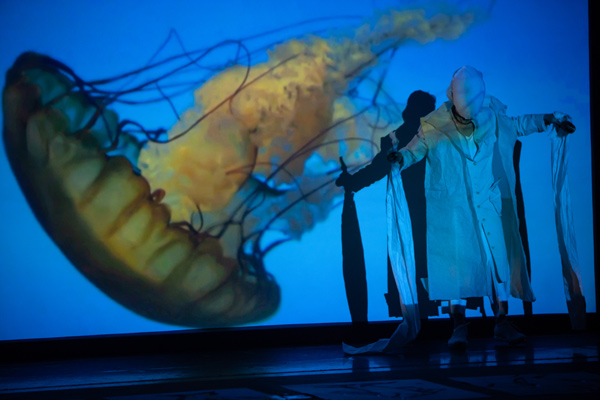To coincide with this year’s fourth edition of the FOG Design+Art Fair, the Fort Mason Center for Arts and Culture invited pioneering multimedia artist Joan Jonas to present two live performances at the center’s Cowell Theater. In the work, titled Moving Off the Land, Jonas gave a fact-based art/science lecture as performance, integrating her signature live drawings and interactions with video projections, with an urgent focus on impending fish extinction and our ancestral relationship with oceans.
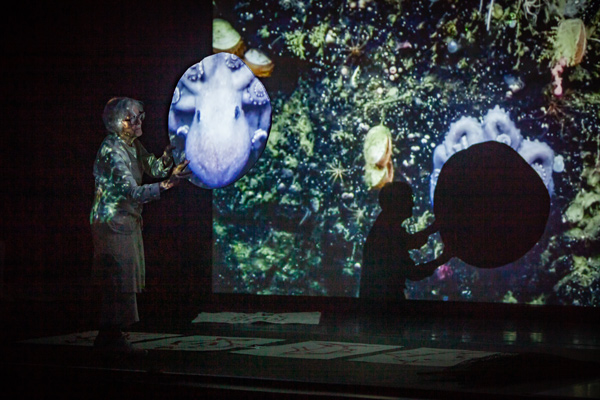
Joan Jonas, Moving Off the Land, January 19, 2019, at Cowell Theater, Fort Mason Center for Arts & Culture. Photo Credit: Fort Mason Center for Arts & Culture/Justine Oliphant
Jonas has focused on nature and the landscape in her videos and performances since 1968, when she made her first work filmed outdoors, titled Wind. Through the years she has presented highly conceptualized engagements—works to be, in her own words, experienced, not understood. Moving Off the Land, which was commissioned by TBA21-Academy, an itinerant cultural producer focused on ecological issues, represents a departure for Jonas. “This is my first collaborative work with a scientist,” the artist said in an interview before the performance. “I taught at MIT for 12 to 13 years and never collaborated with a scientist. I wanted to, but it just never happened.”
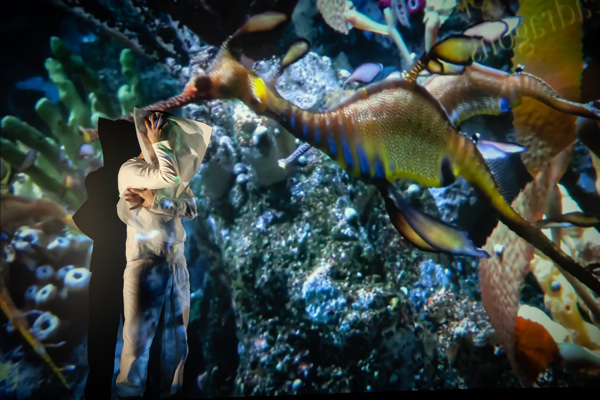
Joan Jonas, Moving Off the Land, January 19, 2019, at Cowell Theater, Fort Mason Center for Arts & Culture. Photo Credit: Fort Mason Center for Arts & Culture/Justine Oliphant
For this performance, Jonas worked with David Gruber, a marine biologist at Baruch College (CUNY) who researches biofluorescent compounds in fish. Interested in understanding how fish perceive, Jonas chose to include in her performance video segments of bioluminescent fish taken with Gruber’s “shark-eye” camera, as well as black and white octopus footage shot by Jean Painlevé. The audience seemed amused to see her lunging with open arms toward the sea life as it swam past her on the big screen.
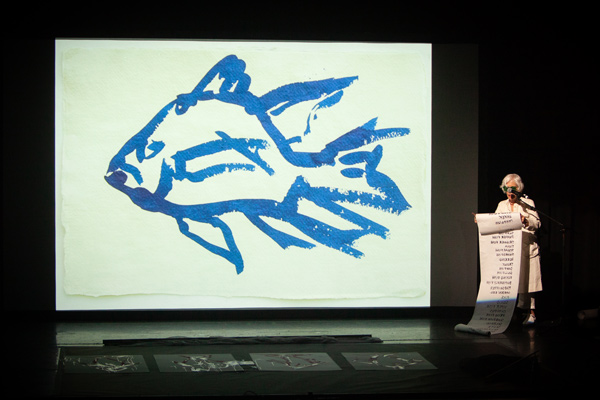
Joan Jonas, Moving Off the Land, January 19, 2019, at Cowell Theater, Fort Mason Center for Arts & Culture. Photo Credit: Fort Mason Center for Arts & Culture/Justine Oliphant
Also on the stage was Ikue Mori, who, spotlighted at the side of the stage, performed music of her own composition with the aid of a computer. Francesco Migliaccio also performed with Jonas, interacting with the video projections employing various surfaces to highlight details of the projected images. Jonas read from a large lectern-type table about the state of our oceans and the impacts of human activity on marine life, including passages from Montgomery’s The Soul of an Octopus, and Carson’s The Edge of the Sea. She also recited a list of species of common fish from a long, handwritten scroll.
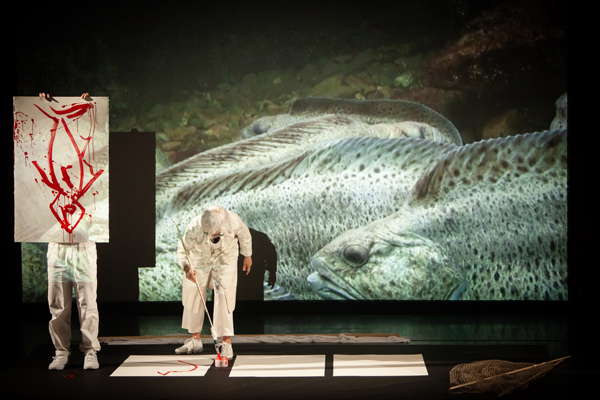
Joan Jonas, Moving Off the Land, January 19, 2019, at Cowell Theater, Fort Mason Center for Arts & Culture. Photo Credit: Fort Mason Center for Arts & Culture/Justine Oliphant
The visual crescendo arrived when Jonas used red paint to make four different fish, each held up by Migliaccio, dripping red “blood” onto the floor as the artist recited about the reduction of fish in our oceans. Jonas said that she made this work in an effort to confront the sadness of the loss. “We came from the oceans,” she said, “and our bodies are made of the same elements.” Jonas feels that we carry memories of the oceans in our minds and our bodies. She seeks out ancient indigenous mythologies that speak to a deeper understanding and connection with nature, stories that can alter our relationship with the natural world today. “We are nature,” she said, adding, “I don’t think my work can change anything. But the discussions we are having around it can.”
Joan Jonas, Moving Off the Land, was performed to coincide with the artist’s multimedia installation, They Come to Us without a Word, on view January 17 – March 10, 2019, in it’s U.S. premiere at Fort Mason Center for Arts & Culture. fortmason.org

